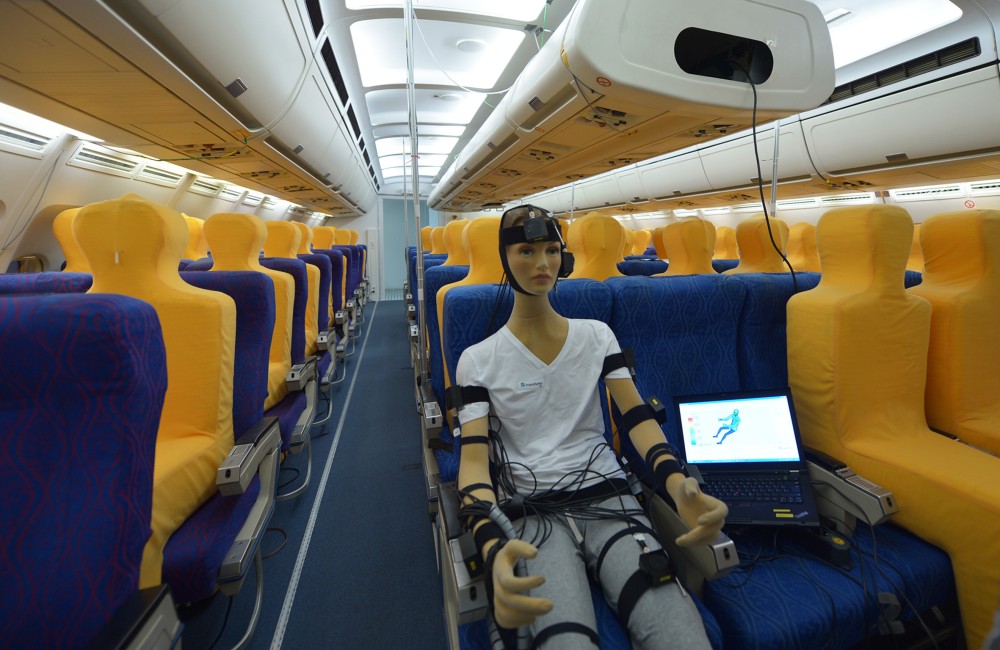
Climate-measuring system DressMAN
Energy Efficiency and Indoor Climate

Tabbed contents
Challenge
Air conditioning poses a particular problem for electric vehicles. When the outside temperature drops to freezing point, the range of an electric car in urban traffic can be halved compared to when temperatures are around 20 °C. Various innovative solutions are currently being developed to reduce the energy required for cooling and heating and thus increase a vehicle’s range. However, common devices for measuring air temperature/air velocity reach their limits when it comes to recording the effect of these solutions on the thermal comfort inside the vehicle at all measuring points. The DressMAN comfort measurement system developed by Fraunhofer IBP comprehensively and objectively measures the local comfort effects on specific parts of the body, as well as on the entire body, by means of freely positionable sensors.
Objectively measuring comfort
The DressMAN sensor system consists of between 16 and 60 sensors. These are either integrated into a wearable suit or attached with straps all over a manikin or a person’s body. During the comfort measurement inside the vehicle, the DressMAN sensor imitates the heat balance of the human skin and measures the so-called equivalent temperature at 28 defined points, i.e. the warmth perceived, taking into account the air temperature, airflow, thermal radiation, humidity and solar radiation. These physically or “objectively” measured local equivalent temperatures are compared with the comfort diagram in the standard DIN EN ISO 14505-2, thus enabling thermal comfort to be evaluated in relation to the individual body parts. To make an in-depth scientific evaluation of the vehicle air conditioning system, the contact areas are also examined. Eight sensors placed on the back and underside of the thigh record the transfer of heat and moisture between the person and the seat.
Evaluating thermal comfort
Taking into account the measured equivalent and contact temperatures, the extended equivalent temperature (Teq) is calculated via the resulting local heat flux densities and the total human heat balance. This enables an overall perception of comfort to be derived. Compared to the definition of equivalent temperature according to DIN EN ISO 14505-2, this approach is unique in that the conduction of heat between the person and the seat is also taken into account. Thus, thermal environmental conditions can be characterized with a single numerical value, making it possible to make a comparative evaluation of different climate scenarios.
Advantages of the comfort measurement technology
The Fraunhofer IBP team developed the first version of DressMAN back in 1990. Since then, our scientific staff has been continuously optimizing the thermal comfort measurement technology. In a decisive step, they significantly reduced the size and thermal mass of the sensor in order to measure rapidly changing effects in cooling and heating phases inside the vehicle. The data are collected via cables or a wireless sensor network (Zigbee mesh). The latter allows sensors to be freely positioned, thus enabling thermal comfort to be assessed in a versatile, localized manner. The measuring system also has an interface to common bus formats (e.g. CAN bus).
Scope of application


The DressMAN measurement system has already helped several OEMs and automotive suppliers to evaluate their new thermal comfort concepts for electric vehicles in climate chamber tests. Apart from the automotive industry, the sensor system for measuring comfort is also deployed in aircrafts and buildings.
| Measurement | Equivalent temperature |
| Standard | DIN EN ISO 14505-2 |
| Measurement objects | Indoor environments, cabin compartments of aircrafts and vehicles, cockpit |
Technical data
| Equivalent temperature | −10 up to +50 °C |
| Air temperature | −10 up to +60 °C |
| Air velocity | 0 to 1 m/s and 0 to 10 m/s |
| Supply voltage | 12 V |
Special features
| Optional sensors | Prepared for integration of additional sensors measuring local air temperature and velocity |
| Local climatic conditions | Measurement of the environmental climatic conditions at up to 16 different body parts for assessment of overall thermal comfort |
Back
- to the search
- to the group Vehicle Climate Control Systems (ibp.fraunhofer.de)
- to the group Thermal Comfort, Models and Simulation (ibp.fraunhofer.de)
- to the department Energy Efficiency and Indoor Climate (ibp.fraunhofer.de)


